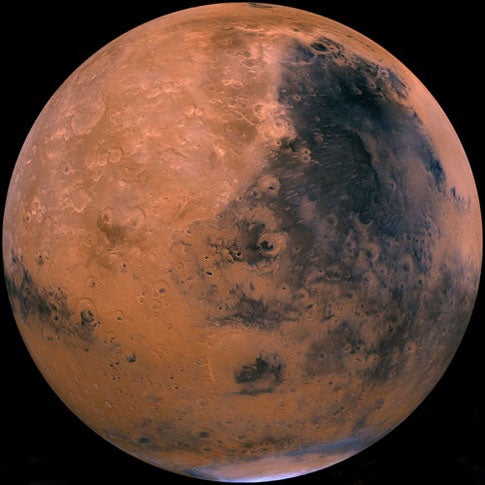R esearch comparing silicon samples from Earth, meteorites and planetary materials provides new evidence that Earth’s core formed under very different conditions from those that existed on Mars. It also shows that Earth and the Moon have the same silicon isotopic composition, supporting the theory that atoms from the two mixed in the early stages of their development.
This latest research, carried out by scientists from Oxford University, the University of California, Los Angeles (UCLA), and the Swiss Federal Institute of Technology in Zurich (ETH), compared silicon isotopes from rocks on Earth with samples from meteorites and other solar system materials. This is the first time isotopes have been used in this way, and it has opened up a new line of investigation into how Earth’s core formed.
On Earth, rocks that make up volcanoes and mountain ranges and underlie the ocean floor are made of silicate — compounds made of silicon and oxygen linked with other kinds of atoms. Silicate dominates down to a depth of 2,900 km — roughly half way to the center of Earth. At this point, there is an abrupt boundary with the dense, metallic iron core.
Studies by Birch in the 1950s demonstrated that the outer core had a density too low to be made of pure iron, so it must also be made up of some lighter elements. Research team member Bastian Georg, a post-doctoral researcher from Oxford University’s Earth Sciences Department said, “We dissolved meteorites, provided by the Natural History Museum in London, in order to compare their isotopic composition with those of rocks from Earth. The silicon was separated from other elements, and the atomic proportions of isotopes measured using a particularly sophisticated mass spectrometer at the ETH in Zurich.”
Professor Alex Halliday, also from Oxford University, explains, “We were quite startled at our results, which showed that the heavier isotopes from silicate Earth samples contained increased proportions of the heavier isotopes of silicon. This is quite different from meteorites from the silicate portions of Mars and the large Asteroid Vesta — which do not display such an effect even though these bodies also have an iron core.”
Silicate samples from Mars and Vesta are identical to a primitive class of meteorites called chondrites, which represent average solar system material from small “planetesimals” that never underwent core formation.
Halliday continues, “The most likely explanation is that, unlike Mars and Vesta, Earth’s silicon has been divided into two sorts — a portion that became a light element in Earth’s core dissolved in metal, and the greater proportion, which formed the silicon-oxygen bonded silicate of the Earth’s mantle and crust.”
At depths, the silicates change structure to denser forms, so the isotopic make-up would depend on the pressure at which metal and silicate separate. Quantifying this effect is the subject of ongoing studies.
UCLA’s Edwin Schauble has produced preliminary calculations that show the isotopic effects found are of the right direction and magnitude. This research provides new evidence that Earth’s core formed under different conditions from those that existed on Mars. This could be explained in part by the difference in mass between the two planets. With Earth being eight times larger than Mars, the pressure of core formation could be higher, and different silicate phases may have been involved. The mass of a planet also affects the energy that is released as it accretes or grows.
Earth accreted most of its mass by violent collisions with other planets and planetary embryos. The bigger the planet, the greater the gravitational attraction and the higher the temperatures generated as the kinetic energy of impacting objects is converted to heat. Some have proposed that outer Earth would have periodically become a “magma ocean” of molten rock as a result of such high temperatures.
There is evidence that Mars stopped growing in the first few million years of the solar system, and did not experience the protracted history of violent collisions that affected Earth. There already exists compelling evidence for relatively strong magnetic fields early in martian history, but a thorough understanding of the martian core must await geophysical measurements by future landers. It is, however, thought that the core of Mars is proportionally smaller than that of Earth, and it probably formed under lower pressures and temperatures.
The research also shows that the Moon has the same silicon isotopic composition as Earth. This cannot be caused by high-pressure core formation on the Moon, which is only about one percent of the mass of Earth. However, it is consistent with the recent proposal that the material that made the Moon during the giant impact between the proto-Earth and another planet, usually called “Theia,” was energetic enough for atoms of the disk from which the Moon formed to mix with those from the silicate Earth. This means the silicon in the silicate Earth must have already had a heavy isotopic composition before the Moon formed about 40 million years after the start of the solar system.










